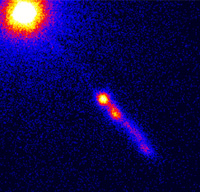November 6, 2000
CXC PR: 00-25
Using the unrivaled high resolution of NASA's Chandra X-ray Observatory, astronomers have seen important new details in the powerful jet shooting from the quasar 3C273. This research, coupled with optical and radio data, may reveal how these very high velocity jets are driven from the supermassive black holes that scientists believe lurk in the center of quasars.
"For the first time, Chandra has given us an X-ray view into the area between 3C273's core and the beginning of the jet," says MIT's Herman Marshall, lead author on the paper submitted to Astrophysical Journal Letters. "Instead of being void of X-ray emission, Chandra has enabled us to detect a faint, but definite, stream of energy."
The high-powered jets driven from quasars, often at velocities very close to the speed of light, have long been perplexing for scientists. Instead of seeing a smooth stream of material driven from the core of the quasar, most optical, radio, and earlier X-ray observations have revealed inconsistent, "lumpy" clouds of gas.
This newly discovered continuous X-ray flow in 3C273 from the core to the jet may reveal insight on the physical processes that power these jets. Scientists would like to learn why matter is violently ejected from the quasar's core, then appears to suddenly slow down.
"If there is a slower car in front on a highway, a faster one from behind will eventually catch up and maybe cause a wreck," says Marshall. "If the jet flow velocity changes, then gas shocks may result, which are akin to car collisions. These gigantic clouds of high-energy electrons, now seen in X rays with Chandra, may indeed be the result of some sort of cosmic traffic pile-up."
The X-ray power produced in one of these pile-ups is tremendous. For example, the X-ray output of the first knot in the jet is greater than that of most Seyfert galaxies, which are thought to be powered by supermassive black holes. The abundance of X-ray emission suggests that large amounts of energy may also be produced in gamma rays, a question that researchers are unable to resolve with current telescopes.
The energy emitted from the jet in 3C273 probably comes from gas that falls toward a supermassive black hole at the center of the quasar, but is redirected by strong electromagnetic fields into a collimated jet. While the black hole itself is not observed directly, scientists can discern properties of the black hole by studying the jet. The formation of the jet from the matter that falls into the black hole is a process that remains poorly understood.
The quasar 3C273 is no stranger to making astronomical news. Discovered in the 1960s, 3C273 was one of the first objects to be recognized a "quasi-stellar" object, due to its incredible optical and radio brightness, but perplexing properties. Only after careful consideration did astronomers determine that 3C273 and others of its ilk were not nearby stars, but instead incredibly powerful objects billions of light years away.
The Chandra observation of 3C273 was made with both the Low Energy Transmission Grating (LETG) and the High Energy Transmission Grating (HETG), in conjunction with the High Resolution Camera (HRC) and the Advanced CCD Imaging Spectrometer (ACIS).
In addition to Dr. Marshall, the team of researchers includes J.J. Drake, A. Fruscione, J. Grimes, D. Harris, M. Juda, R. Kraft, S.S. Murray, D. Pease, A. Siemiginowska, S. Vrtilek, and B.J. Wargelin (Harvard-Smithsonian Center for Astrophysics), P.M. Ogle (MIT), and S. Mathur (Ohio State University.)
The HRC was built for NASA by the Smithsonian Astrophysical Observatory. The HETG and ACIS instruments were built for NASA by the Massachusetts Institute of Technology, Cambridge, MA, and Pennsylvania State University, University Park. The LETG was built by the Space Research Organization of the Netherlands and the Max Plank Institute. NASA's Marshall Space Flight Center in Huntsville, Ala., manages the Chandra program. TRW, Inc., Redondo Beach, Calif., is the prime contractor for thew spacecraft. The Smithsonian's Chandra X-ray Center controls science and flight operations from Cambridge, Mass.
Images associated with this release are available on the World Wide Web at:
MEDIA CONTACTS
Steve Roy
Marshall Space Flight Center, Huntsville, AL
Phone: 256-544-6535
Deborah Halber
Massachusetts Institute of Technology, Cambridge, MA
Phone: 617-258-9276
Megan Watzke
Chandra X-ray Observatory Center, CfA, Cambridge, MA
Phone: 617-496-7998



